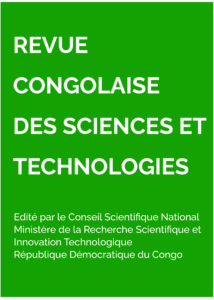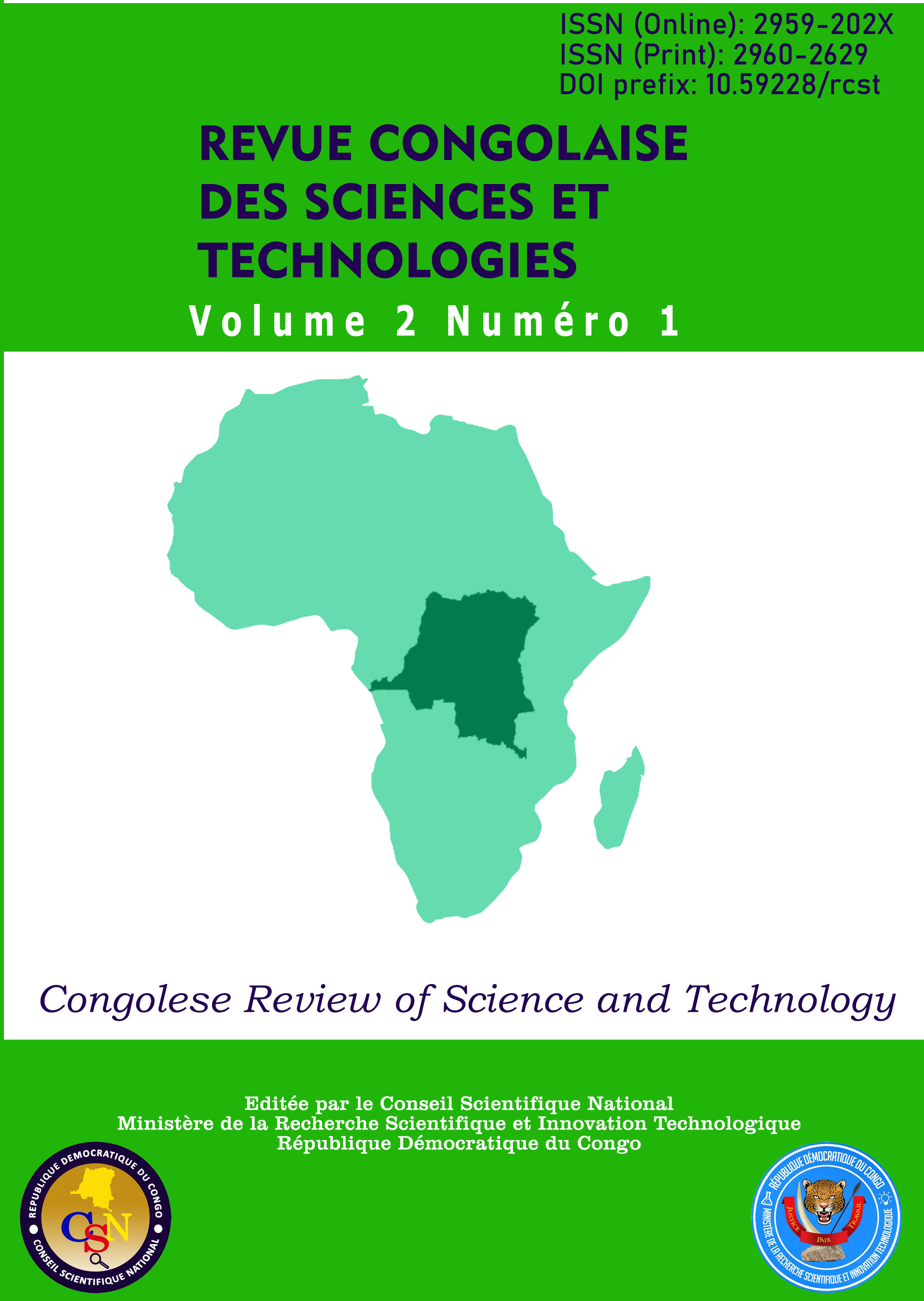Analytical study of timber exploitation in Bikoro Territory (Province of Equateur, Democratic Republic of the Congo)
Main Article Content
Abstract
Logging is an economic activity, but it alters the naturel landscape and disrupts biodiversity. The aim of this study is to
identify the exploited tree species, and to examine the perceptions of the inhabitants of the environmental impact of this
exploitation. Interviews were conducted in eight villages in Bikoro Territory. Data was collected from November 2020 to
January 2021 by administering questionnaires to local resident. A total of 106 respondents took part in the study whose
average age was 40 years, 58% of respondents had an unfavorable opinion on the exploitation of wood because if often
involves the reduction/or disappearance of food animals and insects and seasonal disturbance.
Article Details

This work is licensed under a Creative Commons Attribution-NonCommercial-ShareAlike 4.0 International License.
References
Adjonou, K., Ali, N., Novigno, S. K., Kokou, K.,
Kokutse, A. D., Kokou, K., & Poir, P. E.
(2010). Étude de la dynamique des
peuplements naturels de Pterocarpus erinaceus
Poir. (Fabaceae) surexploités au Togo. Revue
des Sciences Forestières. 306(4), 45–55.
https://doi.org/10.19182/bft2010.306.a20431.
Adjonou, K., Djiwa, O., Kombate, Y., Kokutse, A.D.,
Kokou, K. (2010). Etude de la dynamique
spatiale et structure des forêts denses sèches
reliques du Togo : implication pour une gestion
durable des aires protégées. International
Journal of Biological and Chemical sciences,
(1), 168-183. doi: 10.4314/ijbcs.v4i1.54242
Ali, N. (2009). Pterocarpus erinaceus (Fabaceae)
dans la région centrale du Togo : usages et
impact de l’exploitation sur la distribution
spatiale et caractéristiques structurales.
Mémoire de Technicien supérieur Agricole
l’Infa de Tové, Togo, 43p.
Bayeli, G. I., Joiris, V., Lohandjola, G. N., & Habari,
J. (2019). Contribution à l’étude des plantes
médicinales utilisées dans le traitement des
abcès dans le territoire de Bikoro , province de
l ’ Equateur en RDC Contribution to the study
of medicinal plants used in the treatment of
abscesses in the territory of Bik. International
Journal of Biological and Chemical Sciences,
(1), 353–368.
Bengtsson, J. A. N., Persson, T., & Lundkvist, H.
(1997). Long-Term Effects of Logging Residue
Addition and Removal on Macroarthropods and
Enchytraeids. Journal of Applied Ecology,
(4), 1014–1022.
Bicknell, J. E., Struebig, M. J., & Davies, Z. G.
(2015). Reconciling timber extraction with
biodiversity conservation in tropical forests
using reduced-impact logging. Journal of
Applied Ecology, 52(2), 379–388.
https://doi.org/10.1111/1365-2664.12391
Biloso, A., & Lejoly, J. (2006). Etude de
l’exploitation et du marché des produitsforestiers non ligneux à Kinshasa. Tropicultura,
–3, 183–188.
Blackett, H. & Gardette, E. (2008). Gross-border
flows of timber and wood products in west
Africa. HTSPE Ltd for the European
commission, Brussels, Final report, 125p.
Carvalho, E. A. R., Mendonça, E. N., Martins, A., &
Haugaasen, T. (2020). Effects of illegal logging
on Amazonian medium and large-sized
terrestrial vertebrates. Forest Ecology and
Management, 466, 118105.
https://doi.org/10.1016/j.foreco.2020.118105
Damette, O., & Delacote, P. (2011). Unsustainable
timber harvesting, deforestation and the role of
certification. Ecological Economics, 70(6),
–1219.
https://doi.org/10.1016/j.ecolecon.2011.01.025
Debroux, L., Hart, T., Kaimowitz, D., Karsenty, A.,
& Topa, G. (2007). La forêt en République
Démocratique du Congo Post-Conflit: Anlyse
d’un agenda prioritaire.
FAO. (2020). Global Forest Resources Assessment
- Main report. In Reforming China’s
Healthcare System.
https://doi.org/10.4324/9781315184487-1
Guan, Z., Xu, Y., Gong, P., & Cao, J. (2018). The
impact of international efforts to reduce illegal
logging on the global trade in wood products.
International Wood Products Journal, 9(1), 28–
https://doi.org/10.1080/20426445.2017.1419
Jones, I. J., MacDonald, A. J., Hopkins, S. R., Lund,
A. J., Liu, Z. Y. C., Fawzi, N. I., Purba, M. P.,
Fankhauser, K., Chamberlin, A. J., Nirmala,
M., Blundell, A. G., Emerson, A., Jennings, J.,
Gaffikin, L., Barry, M., Lopez-Carr, D., Webb,
K., de Leo, G. A., & Sokolow, S. H. (2020).
Improving rural health care reduces illegal
logging and conserves carbon in a tropical
forest. Proceedings of the National Academy of
Sciences of the United States of America,
(45), 28515–28524.
https://doi.org/10.1073/pnas.2009240117
Lambin, H. J. G. and E. F. (2001). What Drives
Tropical Deforestation? A meta-analysis of
proximate and underlying causes of
deforestation based on subnational case study
evidence. LUCC Report.
https://doi.org/10.1098/rsbl.2008.0691
Lee-Cruz, L., Edwards, D. P., Tripathi, B. M., &
Adams, J. M. (2013). Impact of logging and
forest conversion to oil palm plantations on soil
bacterial communities in borneo. Applied and
Environmental Microbiology, 79(23), 7290–
https://doi.org/10.1128/AEM.02541-13
Lescuyer, G. (2010). Analyse economique de
l’exploitAtion forestiere Artisanale dans la
province orientale de la RDC : diagnostic
succinct. cirad & cifor
Maindo, A., & Kapa, F. (2014). La foresterie
communautaire en RDC: Premières
expériences, défis et opportunités. Tropenbos
International RD Congo, 159.
Mandjo, B. L., Paulus, J., & Musibono, D. E. (2015).
Evaluation de l ’ importance relative des
activités et des milieux chez les Pygmées
Batwa du territoire de Bikoro , Province de l ’
Equateur , en République Démocratique du
Congo. International Journal of Innovation and
Applied Studies, 11(3), 734–741.
Matricardi, E. A. T., Skole, D. L., Pedlowski, M. A.,
Chomentowski, W., & Fernandes, L. C. (2010).
Assessment of tropical forest degradation by
selective logging and fire using Landsat
imagery. Remote Sensing of Environment,
(5), 1117–1129.
https://doi.org/10.1016/j.rse.2010.01.001
Nichols, E., Larsen, T., Spector, S., Davis, A. L.,
Escobar, F., Favila, M., & Vulinec, K. (2007).
Global dung beetle response to tropical forest
modification and fragmentation: A quantitative
literature review and meta-analysis. Biological
Conservation, 137(1), 1–19.
https://doi.org/10.1016/j.biocon.2007.01.023
Obaji, A. A., Abua, O. D., Ado, A. R., & Michael, I.
N. (2020). Perception of Forest Stakeholders on
Logging Ban in Cross River State, Nigeria.
Asian Journal of Research in Agriculture and
Forestry, 5(2), 1–15.
https://doi.org/10.9734/ajraf/2020/v5i230078
OIBT (2008). Mission d’appui au Gouvernement du
Togo en gestion durable des forêts. Rapport de
la mission diagnostic Soumis au conseil
international du bois tropicaux, 71p.
Ongona, P. T., Lescuyer, G., Vleminckx, J., Abdala,
B. A., & Lokombe, D. (2016). Utilité d’une
typologie des exploitants artisanaux de bois
pour contribuer à la formulation d’une politiquepublique en province Orientale (RD Congo).
Biotechnology, Agronomy and Society and
Environment, 20(4), 468–481.
https://doi.org/10.25518/1780-4507.13242
RDC, J. officiel. (2002). Loi n° 011/2002 portant
Code Forestier de la RDC. 102.
Samndong, R. A. (2016). Institutional Choice and
Fragmented Citizenship in Forestry and
Development Interventions in Bikoro Territory
of the Democratic Republic of Congo. Forum
for Development Studies, 43(2), 251–279.
https://doi.org/10.1080/08039410.2015.111542
Samndong, R. A., Bush, G., Vatn, A., & Chapman,
M. (2018). Institutional analysis of causes of
deforestation in REDD+ pilot sites in the
Equateur province: Implication for REDD+ in
the Democratic Republic of Congo. Land Use
Policy, 76(May 2017), 664–674.
https://doi.org/10.1016/j.landusepol.2018.02.04
Trefon, T. (2008). La réforme du secteur f orestier en
république démocratique du congo: Défis
sociaux et faiblesses institutionnelles. Afrique
Contemporaine, 227(3), 81–93.

